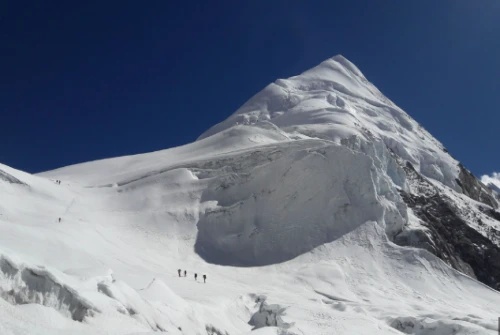Lobuche Peak and Island Peak via the Everest Base Camp and Gokyo Cho La Pass route offer a thrilling and comprehensive adventure in the Everest region of Nepal. This expedition combines the challenge of scaling two stunning peaks with the awe-inspiring trek to Everest Base Camp and the crossing of the scenic Gokyo Cho La Pass.
Combining the climbs of Lobuche Peak and Island Peak via the Everest Base Camp and Gokyo Cho La Pass route provides a comprehensive and thrilling adventure. It allows you to experience the iconic Everest Base Camp trek, cross the stunning Gokyo Cho La Pass, and conquer two majestic peaks in the Himalayas. However, it's important to note that attempting these climbs requires physical fitness, prior mountaineering experience, and proper acclimatization. It is highly recommended to undertake this expedition with the assistance of experienced guides or mountaineering companies who can ensure your safety and provide the necessary support throughout the journey.
This expedition spans approximately 22 to 25 days, allowing sufficient time for trekking, acclimatization, and peak climbing. The journey begins with trekking through the picturesque Sherpa villages such as Namche Bazaar, Tengboche, Dingboche, and Chhukung, each offering unique cultural experiences and stunning views of Himalayan giants like Mount Everest (8,848m), Lhotse, Nuptse, and Ama Dablam.
The crossing of the Gokyo Cho La Pass (5,420m) is one of the highlights of the expedition, providing breathtaking panoramic views over the Gokyo Lakes, glaciers, and surrounding peaks. This high-altitude pass requires good trekking skills, balance, and physical endurance, making it a favorite among experienced trekkers.
The climbs of Lobuche Peak (6,119m) and Island Peak (Imja Tse, 6,189m) are considered among Nepal’s most accessible trekking peaks but still require technical skills such as glacier travel, use of crampons, ice axe handling, and rope techniques. Proper training and prior mountaineering experience are essential for safety and success.
Conclusion
The Lobuche Peak and Island Peak expedition via Everest Base Camp and Gokyo Cho La Pass is truly an unforgettable Himalayan journey that masterfully blends high-altitude trekking, Sherpa culture immersion, and technical mountaineering. This challenging yet immensely rewarding adventure is perfectly suited for experienced trekkers and climbers who are eager to push their physical and mental limits while soaking in the awe-inspiring natural beauty and cultural richness of Nepal’s iconic Everest region.
Guided by professional mountain guides and supported by expert Sherpa teams, with a carefully planned itinerary emphasizing proper acclimatization, safety, and thorough physical preparation, you will confidently and safely conquer two majestic Himalayan peaks Lobuche Peak and Island Peak. Along the way, you will also cross the spectacular Gokyo Cho La Pass, one of the most scenic and challenging high mountain passes in the world, while trekking through some of Nepal’s most famous and breathtaking landscapes.
This comprehensive expedition package promises an enriching experience filled with breathtaking panoramas, unforgettable cultural encounters, and the profound personal achievement of summiting Himalayan giants. Whether you are seeking to elevate your mountaineering skills or simply experience one of the most legendary trekking and climbing routes on Earth, this adventure offers it all.
Are you ready to embark on this epic Everest region expedition and create memories that will last a lifetime?




 based on 1 review
based on 1 review